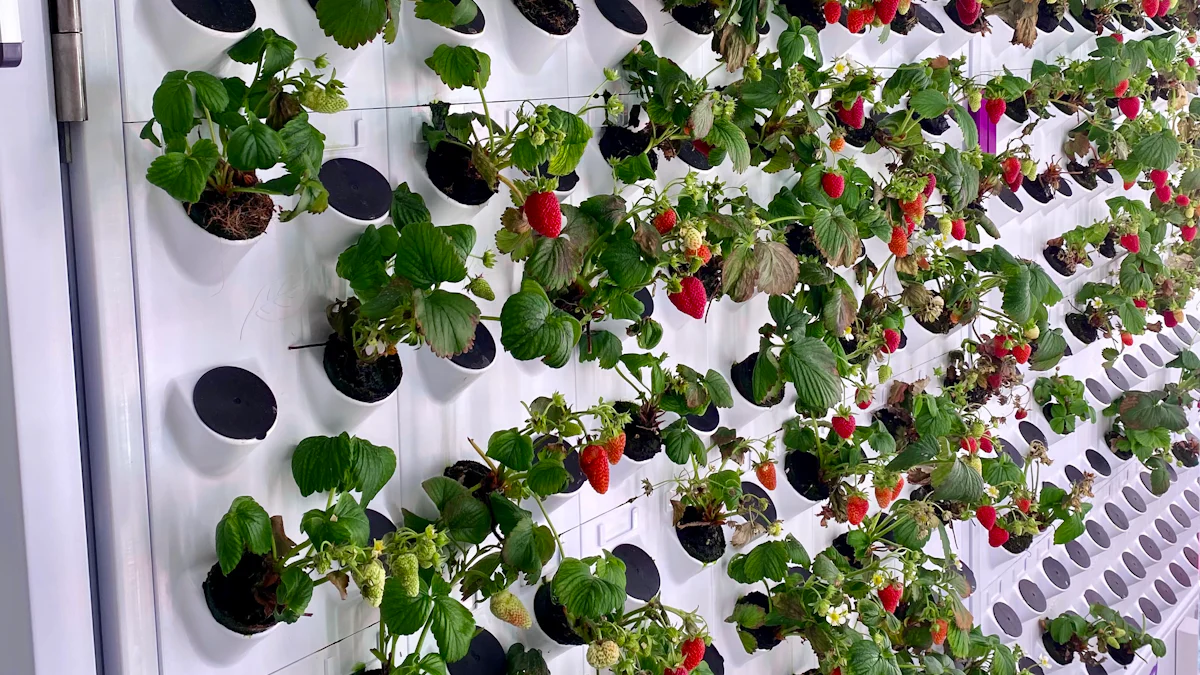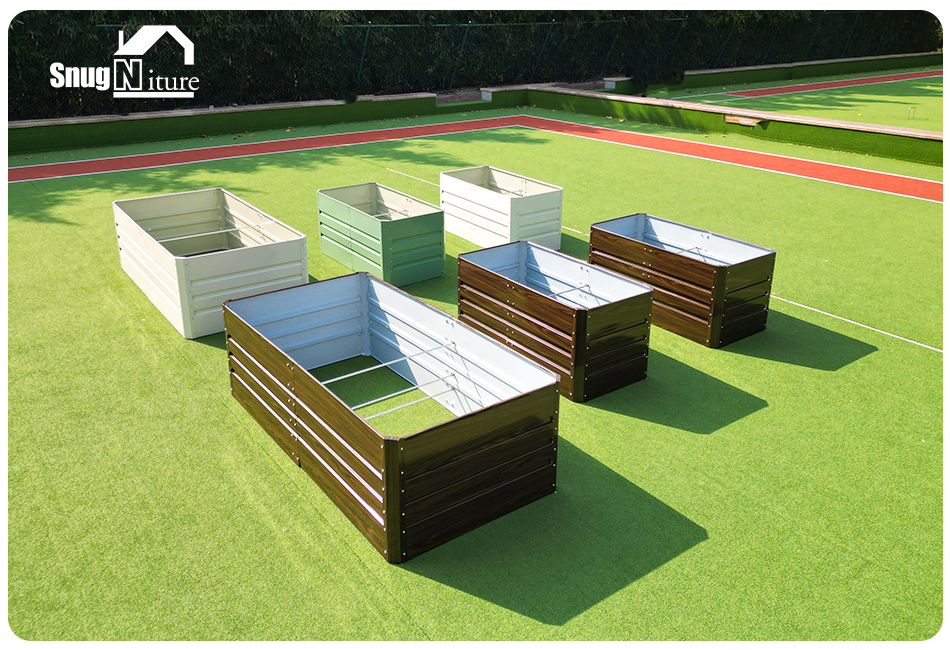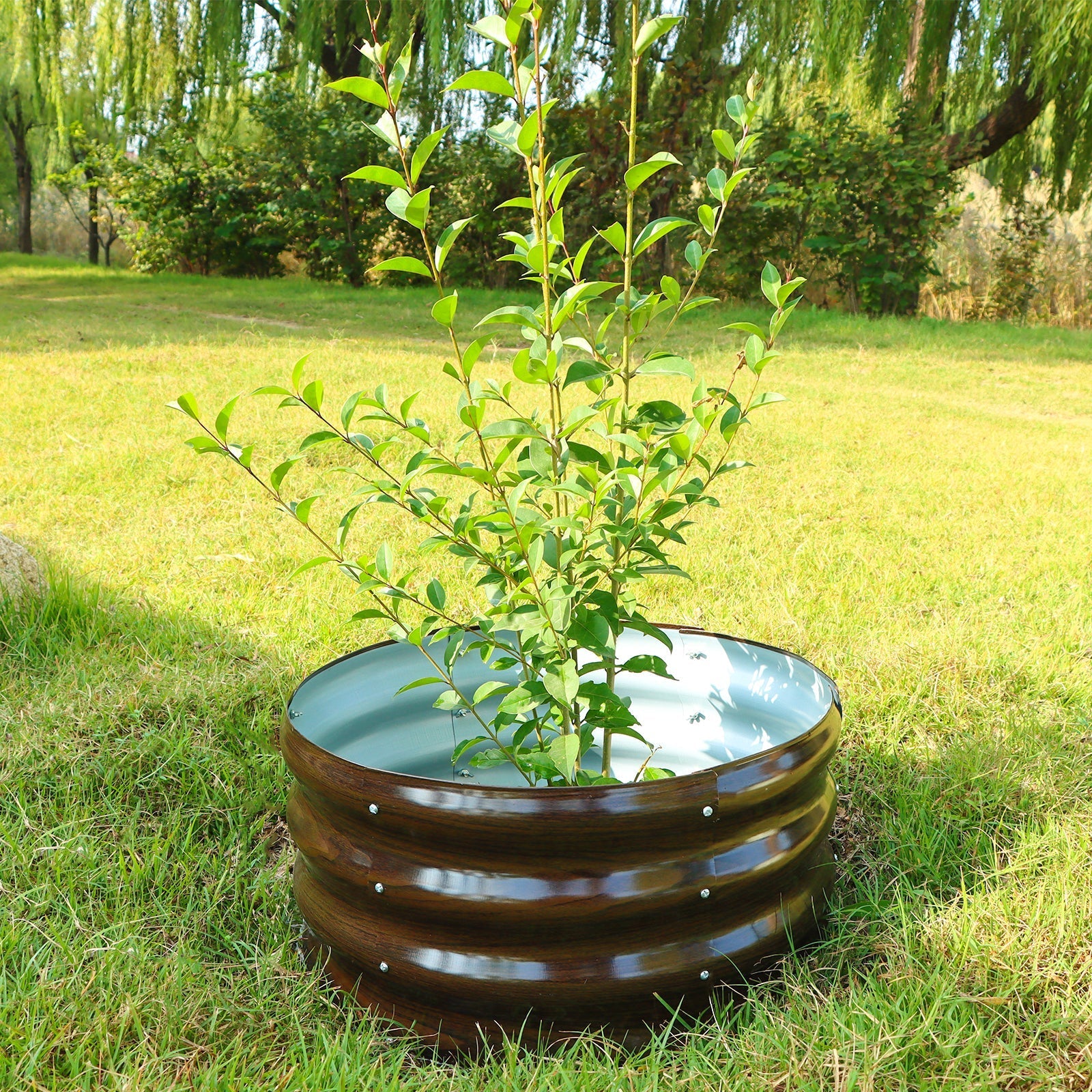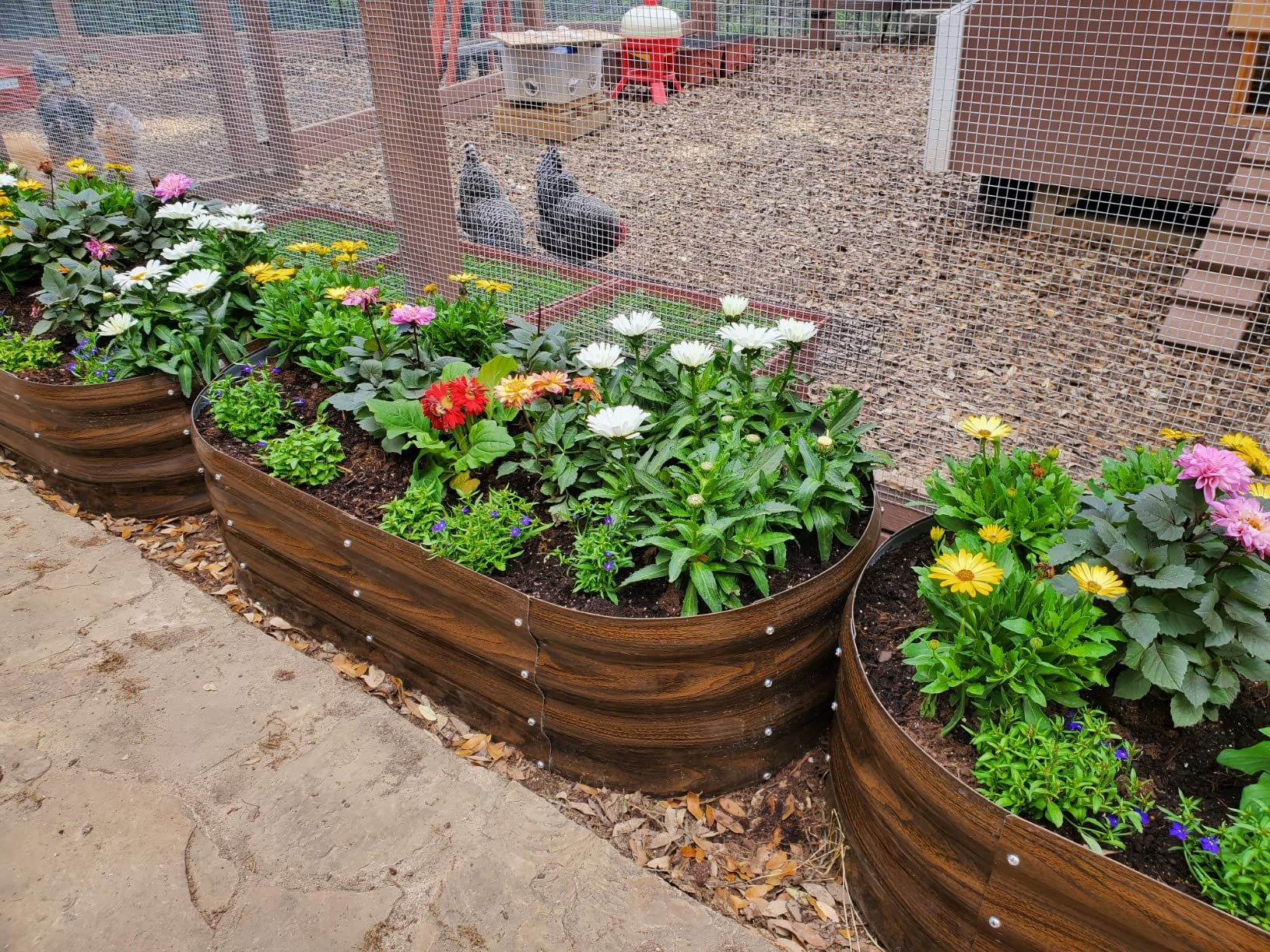Imagine transforming your outdoor space into a thriving garden with ease. SnugNiture's Modular Metal Raised Garden Beds make it possible. These beds simplify gardening by offering better drainage, less soil erosion, and fewer weeds. Their modular design lets you customize layouts to fit your space, whether you're growing vegetables, herbs, or flowers. Plus, they’re durable and free from chemical leaching, unlike traditional wooden beds. With these raised garden beds, you’ll enjoy more growing space and healthier plants. Ready to explore creative ideas and start your gardening journey? Let’s dig in!
Key Takeaways
Change your yard with SnugNiture's Metal Raised Garden Beds. These help with better water drainage and healthier plants.
Use tiered designs or vertical gardening to grow more plants in small spaces.
Make special gardens, like ones for bees or cooking herbs. This helps nature and gives you fresh flavors.
Add pretty designs and borders to make your garden look nice and stay organized.
Prepare soil well and water correctly to help your garden grow and give lots of crops.
Creative Design Ideas for Raised Garden Beds

Tiered Raised Garden Beds
Maximizing small spaces with tiered designs.
If you’re working with limited space, tiered raised garden beds are a game-changer. These designs let you grow more plants vertically, making the most of every inch. You can create a stepped effect using materials like stone or wood, or go for a sleek, modern look with modular metal planters. Arrange taller plants at the back and shorter ones in the front to add depth and make harvesting easier. Pairing perennial flowers with ornamental grasses can also create a stunning visual display. With tiered designs, you’ll not only save space but also enjoy a more organized and efficient garden.
Creating a cascading plant effect for visual appeal.
Want to make your garden stand out? A cascading plant effect can turn your raised garden bed into a showstopper. Use trailing plants like petunias, nasturtiums, or sweet potato vines to spill over the edges of each tier. This creates a lush, flowing look that’s both functional and beautiful. You can even mix in climbing plants like beans or peas for added height and texture. The result? A garden that’s as visually appealing as it is productive.
Vertical Gardening with Raised Beds
Using trellises and supports for climbing plants.
Adding vertical elements like trellises or arbors to your raised garden bed is a smart way to save space and boost plant growth. Climbing plants like cucumbers, tomatoes, and pole beans thrive when they grow upward. This not only frees up ground space but also improves sunlight exposure, leading to healthier plants and higher yields. Plus, vertical gardening makes harvesting a breeze since everything is within easy reach.
Combining vertical and horizontal gardening for higher yields.
Why choose between vertical and horizontal gardening when you can have both? Combine the two to maximize your garden’s productivity. Use the raised bed for root vegetables like carrots or radishes, while trellises support climbing plants above. This layered approach lets you grow more in the same space, making it perfect for small gardens or urban settings. It’s a win-win for your plants and your harvest.
Themed Raised Garden Beds
Designing a pollinator-friendly garden.
If you love seeing butterflies and bees in your garden, a pollinator-friendly raised garden bed is a fantastic idea. Fill it with flowering plants like lavender, coneflowers, and sunflowers to attract beneficial insects. These pollinators not only add life to your garden but also help your plants thrive. Grouping these flowers in a raised bed makes it easier to manage and creates a vibrant focal point in your outdoor space.
Creating a culinary herb garden with raised beds.
Imagine stepping outside to pick fresh herbs for your meals. A culinary herb garden in a raised bed makes this dream a reality. Plant popular herbs like basil, mint, and rosemary in neat rows or clusters. Raised beds provide excellent drainage, which is essential for herbs to thrive. You can even add a spiral design to maximize space and create an eye-catching feature. With your own herb garden, you’ll always have fresh flavors at your fingertips.
Decorative Layouts and Edging
Using modular designs to create geometric patterns.
Why settle for a plain garden layout when you can turn it into a work of art? With SnugNiture's modular raised garden beds, you can create stunning geometric patterns that elevate your outdoor space. The modular design gives you the flexibility to arrange the beds in shapes like squares, hexagons, or even spirals. These patterns not only look amazing but also help you organize your plants more effectively.
Hexagonal layouts: Perfect for creating a honeycomb effect. This design works great for flowers or herbs, giving your garden a unique and modern vibe.
Spiral arrangements: Ideal for maximizing space. You can plant taller crops in the center and shorter ones along the edges for a layered look.
Checkerboard patterns: Alternate between raised beds and open spaces. This layout adds symmetry and makes pathways more accessible.
Tip: Use contrasting plants or flowers in different sections to make the patterns pop. For example, pair green leafy vegetables with bright blooms for a striking visual effect.
Enhancing aesthetics with decorative elements like stones or mulch.
Adding decorative touches to your raised garden beds can transform them from functional to fabulous. Simple elements like stones or mulch can make a big difference in the overall look of your garden. Plus, they’re practical too!
Stones: Line the edges of your garden beds with smooth river rocks or colorful pebbles. This not only defines the space but also prevents soil from spilling over.
Mulch: Spread mulch around your plants to create a clean, polished appearance. It also helps retain moisture and keeps weeds at bay.
Edging materials: Use bricks, wooden planks, or metal strips to frame your beds. These materials add structure and a touch of elegance.
Note: Choose materials that complement your garden’s theme. For a rustic look, go with natural stones. For a modern feel, opt for sleek metal or monochrome pebbles.
With these ideas, your raised garden beds will become the centerpiece of your outdoor space. It’s time to get creative and let your garden reflect your personal style! 🌱
Planting Suggestions for Raised Garden Beds
Vegetables for Raised Beds
Top vegetables to grow in raised garden beds
Growing vegetables in a raised garden bed is a fantastic way to ensure healthy, thriving plants. Some vegetables perform exceptionally well in these beds due to the warm, well-draining soil they provide. Here are some top picks:
Tomatoes: They love the deep, warm soil of raised beds, which supports their roots and boosts growth.
Carrots: Raised beds offer the deep, stone-free soil carrots need to grow straight and strong.
Lettuce and spinach: These leafy greens thrive in nutrient-rich soil, which is easy to maintain in a raised garden bed.
Peppers and cucumbers: Both enjoy the warm, loose soil that raised beds provide.
Bush beans: Quick to grow and perfect for small spaces.
By choosing these vegetables, you’ll enjoy a productive and rewarding garden.
Companion planting strategies for better growth
Companion planting can take your vegetable garden to the next level. Pairing certain plants together improves growth, deters pests, and enhances flavor. Here’s a quick guide:
Benefit |
Description |
|---|---|
Protecting and shielding crops |
Hardier plants shield delicate ones from harsh weather. |
Improving pollination |
Flowers like marigolds attract pollinators to nearby vegetables. |
Repelling pests |
Herbs like basil deter pests when planted near tomatoes. |
Enriching the soil |
Legumes like beans fix nitrogen, enriching the soil for other plants. |
For example, plant tomatoes with basil or onions to repel pests and enhance flavor. Pair cabbage with radishes to trap pests away from the main crop. These combinations create a healthier, more balanced garden.
Flowers for Raised Garden Beds
Selecting flowers that thrive in raised beds
Flowers add beauty and biodiversity to your garden. Some thrive particularly well in raised beds:
Zinnias: Easy to grow and available in vibrant colors, perfect for beginners.
Black-eyed Susans: Hardy perennials that bring a touch of the prairie to your garden.
These flowers not only look stunning but also attract pollinators, which benefit your vegetables and herbs.
Seasonal flower planting for year-round beauty
To keep your garden colorful all year, plan for seasonal blooms:
Plant spring bulbs like tulips for early-season color.
Mix annual flowers like marigolds among your vegetables for a lively summer display.
Add fall-blooming flowers like chrysanthemums to extend the season.
Position flowers throughout your garden to attract bees and butterflies, creating a vibrant and thriving ecosystem.
Herbs for Everyday Use
Popular herbs to grow in raised beds
Herbs are a must-have for any garden. They’re easy to grow and incredibly useful in the kitchen. Some popular choices include:
Basil: Perfect for pesto and pairs well with tomatoes.
Mint: Great for teas and cocktails, but keep it contained as it spreads quickly.
Rosemary: A hardy herb that adds flavor to meats and vegetables.
Raised beds provide the excellent drainage herbs need to thrive, making them an ideal choice.
Tips for harvesting and maintaining herbs
To keep your herbs healthy and productive, follow these tips:
Use clean scissors or pruners to avoid spreading diseases.
Harvest when leaves are dry to prevent mold.
Follow the “one-third rule” – never take more than a third of the plant at once.
Place your raised garden bed in a sunny spot, and add compost regularly to enrich the soil. With proper care, your herbs will flourish, providing fresh flavors for your meals all season long.
Space Optimization Tips for Raised Garden Beds

Gardening in Small Spaces
Arranging modular raised beds for maximum efficiency.
When space is tight, modular raised garden boxes are your best friend. Their flexibility lets you arrange them in ways that maximize efficiency while keeping your garden organized. Try grouping the boxes in threes for a balanced look or arranging them parallel for a neat, formal design. Want something more creative? Mix different types of boxes for a casual, eclectic vibe.
For even better results, consider these layouts:
L-Shaped Layout: Perfect for corners, this design maximizes planting areas while saving space.
U-Shaped Layout: This cozy setup makes every plant easy to reach.
Zigzag Design: Adds visual interest and improves drainage and sunlight exposure.
Modular metal garden boxes also reduce maintenance and last longer than wooden ones. They’re a smart choice for small spaces.
Utilizing vertical space to grow more plants.
Vertical gardening is a game-changer when you’re short on room. Use trellises, pergolas, or obelisks to support climbing plants like cucumbers or beans. Position these supports on the north or east side of your garden boxes to avoid shading other plants. You can even create a walk-through vegetable arch using metal uprights and cattle panels. It’s functional and adds charm to your garden.
Another idea? Build a bean teepee. It’s simple, space-saving, and looks fantastic. With vertical gardening, you’ll make the most of your growing space.
Urban Gardening with Raised Beds
Setting up raised beds on balconies or patios.
Urban gardening is easier than you think. Raised garden boxes fit perfectly on balconies or patios, turning even the smallest spaces into lush gardens. Use high-quality soil to ensure your plants thrive. Plan your layout carefully to keep everything accessible and easy to maintain. Modular metal boxes are ideal here—they’re durable and require minimal upkeep.
Challenge |
Solution |
|---|---|
Poor soil quality |
Use high-quality soil |
Limited space |
Plan for accessibility and maintenance |
Need for proper materials |
Select appropriate building materials |
Maintenance requirements |
Invest in a structure that is easier to maintain over time |
Choosing compact plants for urban environments.
Compact plants are your go-to for urban gardening. Herbs like basil and mint, or vegetables like cherry tomatoes and bush beans, thrive in small spaces. Pair them with flowers like marigolds to add color and attract pollinators. These choices make your urban garden both productive and beautiful.
Multi-Purpose Gardening Areas
Combining seating areas with raised garden beds.
Why not make your garden a place to relax? Place raised garden boxes around the edges of your outdoor space to create a natural boundary. You can even use them to divide your garden into zones, like seating areas or dining spots. Incorporating raised boxes into your hardscape design adds both function and style.
Creating pathways for easy access between raised beds.
Pathways make your garden more accessible and visually appealing. Use wood chips to keep weeds down and maintain a tidy look. Make sure paths are at least 18 inches wide so you can easily move a wheelbarrow through. For extra durability, lay landscaping fabric under the wood chips. These simple steps will keep your garden organized and easy to navigate.
Maintenance and Care for Raised Garden Beds
Soil Preparation and Fertilization
Choosing the right soil mix for raised garden beds.
The foundation of a thriving garden starts with the right soil mix. For raised garden beds, aim for a blend that balances nutrients, drainage, and aeration. A great mix includes equal parts of garden soil, organic matter like compost or peat moss, and porous materials such as vermiculite or perlite. This combination ensures your plants get the nutrients they need while preventing waterlogging.
You can also layer your bed for added benefits. Begin with a bottom layer of tree limbs, sticks, or fallen leaves. Add a 50/50 mix of compost and topsoil on top. As the organic matter breaks down, it enriches the soil, creating a nutrient-rich environment for your plants.
Adding compost and organic matter for healthy plants.
Compost is your garden’s best friend. Start by adding a base layer of organic materials like old logs, grass clippings, or leaf mold. Top this with soil and finish with a layer of compost. This method not only improves drainage but also provides essential nutrients. Replenish your beds with fresh compost at the start of each season to keep your plants healthy and productive.
Watering Techniques for Raised Beds
Installing drip irrigation systems for convenience.
Drip irrigation systems are a game-changer for raised garden beds. They deliver water directly to the roots, ensuring even hydration and reducing waste. This method keeps leaves dry, which helps prevent fungal diseases. Plus, it saves you time and effort, especially during hot summer months. With consistent watering, your plants will thrive, and you’ll conserve water in the process.
Preventing overwatering or underwatering in raised beds.
Proper watering is key to a successful garden. Check soil moisture regularly to avoid overwatering or underwatering. Adjust your watering schedule based on weather conditions. For efficiency, use drip irrigation or olla systems. Always water the roots directly and avoid spraying leaves to reduce evaporation. Collecting rainwater is another eco-friendly way to keep your garden hydrated.
Ensuring Durability and Longevity
Protecting raised garden beds from weather damage.
Weather can take a toll on your garden beds, but a few precautions can help. Use mulch to absorb excess water and prevent pooling around roots. Ensure proper drainage by incorporating organic matter into the soil and creating channels. For small plants, protective covers or cloches shield them from heavy rain and frost, keeping them safe year-round.
Cleaning and maintaining SnugNiture beds for long-term use.
To keep your SnugNiture raised garden beds in top shape, clean them regularly. Remove debris and rinse the metal surfaces to prevent buildup. Check for signs of wear and apply a protective coating if needed. These simple steps will extend the life of your beds, ensuring they remain a reliable part of your garden for years to come.
SnugNiture Modular Metal Raised Garden Beds offer you a simple way to elevate your gardening game. These planters are versatile, durable, and eco-friendly, making them perfect for any space. They help you grow healthier plants with less effort by improving drainage, reducing weeds, and enriching soil quality. Plus, they extend your growing season, giving you more time to enjoy your garden.
Why not try out some of the creative ideas we’ve shared? Whether it’s a tiered design, a pollinator-friendly garden, or a decorative layout, these planters let you customize your space to match your style. You’ll love how easy it is to grow vegetables, flowers, and herbs while creating a sustainable, beautiful garden.
With better water management and minimized soil compaction, these planters make gardening accessible for everyone. They’re not just functional—they’re a step toward a greener future. So, grab your SnugNiture planter and start transforming your outdoor space today. Your garden will thank you!



